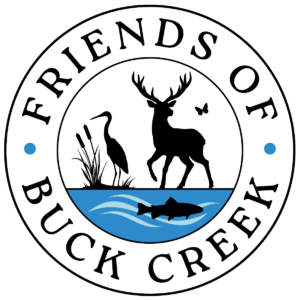
From Friends of the Rouge:
The Clean and Open Method was developed by the Riparian Corridor Management Technical Advisory Committee, which was made possible by a partnership between Friends of the Rouge, the Rouge River Advisory Council’s Habitat Committee, the Michigan Department of Environmental Quality and the Wayne County Department of Environment.
Clean and Open Method
- PLAN – Address public health, legal access, safety concerns, define point of access to river, determine depth of water, flow and emergency plans.
- CLEAN – Remove urban rubbish (man-made materials) and dispose properly.
- OPEN – Move or cut loose, floating debris to allow a passage for flow. Use a handsaw or chain saw to make the opening wide enough to allow flow through logjam.
- Place excess woody debris along streambanks and in the adjacent riparian corridor to create habitat.
- Leave woody debris that is embedded in the stream’s banks or bottom undisturbed.
- Minimize impact to the riparian corridor at work site.
Benefits
- Requires no Michigan Department of Environmental Quality Inland Lakes and Streams Permit.
- Creates, preserves and enhances fish, aquatic invertebrate and wildlife habitat structure.
- Reduces localized flooding and erosion while maintaining flow reduction and sediment deposition benefits.
- Increases and/or maintains the river’s aesthetic value.
- Meets the habitat creation, riparian vegetation preservation and erosive flow reduction requirements of the Michigan General Stormwater permit.
- Saves money by eliminating the need to use heavy machinery and extensive restorative work.
- Involves multiple volunteers and activities can be done by hand.
Materials
Some equipment you might need for repositioning, modifying or removing large woody debris are:
- Hand saws
- Stout rope
- Come-alongs, block & tackle
- Chain saws (to be operated by trained users,)
Volunteer Activities
Some activities for volunteers include:
- Rope teams to move or remove loose, floating woody debris
- Trash removal teams for man-made materials in stream, on floodplain or riparian corridor
- Logjam opening team
- Equipment support team providing equipment to workers in stream
- Planting teams for native trees, shrubs and grasses in riparian buffer zone
Frequently Asked Questions
Why is NO PERMIT required for this work?
To fully understand why NO PERMIT is required, one must understand what work REQUIRES a permit. Please review Part 301, Inland Lakes and Streams, of Michigan’s Natural Resources and Environment Protection Act, 1994 PA, 451, as amended. Any work within 500 feet of a stream, that may cause an earth change and/or may alter or install a structure could require a permit from the Regulatory agency (MDEQ). There is a fine line between what work needs a permit and what does not. If proposed work significantly alters soil or water flow, impedes navigation, or secures structure to the bank or bottom of the watercourse, it will require a permit. Under these conditions, if the proposed work includes only moving/removing tangled-up floating wood, cutting back wood that is secured to banks or bottom, keeping impact to the streambanks and river light, and not securing anything to the banks or bottom of the watercourse, then it does not need a permit. The WDM 101 method was created in partnership with Michigan Department of Environmental Quality (MDEQ) and the MDNR to help create proper direction through these WDM 101 guidelines. If still unsure whether proposed work will need a permit, please contact the local State regulatory district office for further clarification.
Who can do this work?
Anyone (including public entities and private citizens) can implement WDM 101 techniques in a watercourse if they follow the basic guidelines outlined in this document. For safety reasons, one person efforts are discouraged. Two people can accomplish useful improvements safely. We recommend partnership and teamwork to reduce workload and to accomplish more complete projects.
Where can this work be done?
WDM 101 can be implemented in any river system where logjams are present. Some woody debris buildups will not be causing any negative impacts and therefore are unnecessary to work on. However, some may be causing ‘excessive’ flooding (flooding that is directly damaging property,) extreme bank erosion and may be trapping urban rubbish. These types of logjams could benefit from CLEAN and OPEN work. Some jams may only be trapping rubbish but not causing flooding or erosion. These logjams can benefit from the CLEAN process but really do not require any OPEN work. There are some logjams that may be causing problems that can directly impact human safety or causing real property damage (an example is an eroding building foundation.) In this case, the WDM 101 method may not apply and other WDM methods could be considered.
How is this work done?
Determine what you want to accomplish. If the goals of the activity are to remove the man-made trash and improve the flow through an existing logjam or to alleviate localized flooding and erosion, then WDM 101 is the proper method. Know your work site. Determine how safe the watercourse is to work in. Define a point to get in and out of the river. Locate where you will place excess woody debris along the streambank and in the riparian corridor. Develop a work plan that is focused on safety and teamwork. If there are questions, ask for assistance. Make sure that the work team understands the scope of work and assignments. One common issue during projects is that, due to the enthusiasm of the work crews, the logjam is completely removed through the course of the work. Provide necessary tools and materials and remember to take your time and works safely. Remember, if you only Clean a portion and Open a portion, you have done some useful work. Every effort helps and the accumulative effects of this work over time will make a difference.


